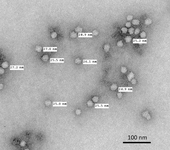Highlight
Development of novel aminoglycoside encapsulated nanoparticles
Achievement/Results
Development of novel aminoglycoside encapsulated nanoparticles: Aminoglycosides are a class of compounds that exhibit toxicity against bacterial cells by binding to the small ribosomal subunit, eventually causes cell death, thus making aminoglycosides potent antibiotics. However, the limitation of widespread use of these compounds as antibiotics is due to severe toxicity that can result in kidney damage and/or deafness. To address this issue, a nanoparticle-based approach has been developed by NSF IGERT trainee Mike Cuccarese. Clinically available aminoglycoside, gentamicin, has been encapsulated within chitosan nanoparticle to help improve bioavailability and decrease toxicity. In addition, several novel aminoglycoside analogues are also being developed. Preliminary results indicate successful encapsulation of gentamicin within chitosan nanoparticles with high loading efficiency and a very tight control on the size distribution.
Address Goals
Current treatment methods involving antibiotics has serious limitations such as ineffective dosages, drug resistance and unwanted side-effects. Therefore, development of new methods to deliver antibiotics is a very important field of research. Nanotechnology offers a new method to administer antibiotics with improved efficacy and minimal side effects. In this NSF IGERT project, a novel method using nanoparticles was developed to encapsulate gentamicin. The potential benefit of this project will be in improving bioavailability of antibiotics in treatment of diseases with minimal side-effects.






